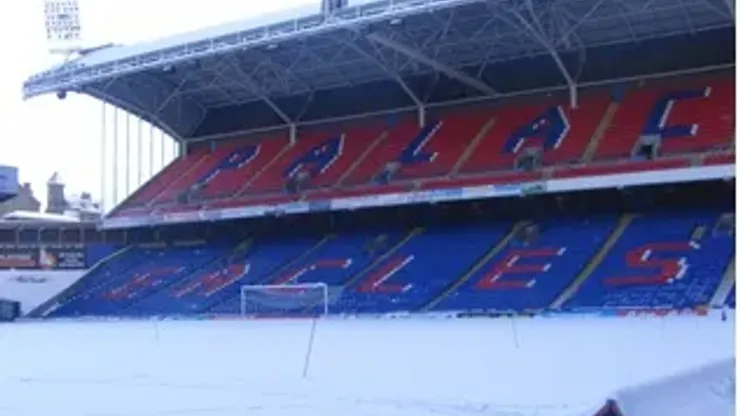Now I am well aware that neither you nor I (the man in the street) can do anything about the weather itself, but maybe the Clubs outside the Premier League should look at alternative strategies in an attempt to make sure games are played despite the weather.
In the cold light of day the Premier League is in a world of its own, The Royal Family of the Football League if you like, BUT the foundation, the bread and butter of our game emanates from the lower leagues.
The Championship, the second tier of our national game is susceptible to the same problems and issues as the Blue Square League when games are called off.
Lost revenue through various channels including television rights, match sponsorship and ticket sales, match re-scheduling, administration costs, disruption and disappointment for the fans and general inconvenience.
For example, Crystal Palace were due to meet Plymouth Argyle at Home Park on Saturday 10th January, the match was postponed and is now re-scheduled for Tuesday 17th February .
How feasible and fair is it on the modern day fan to even contemplate a 460 mile round-trip from London, a nine-hour vehicle journey in MIDWEEK, and in the current economic climate!
A day off work, traveling costs, the long trip, returning home in the early hours and getting up for work the very same morning. Preposterous!
However the tenacity of some of our supporters (as with many Clubs) means there will without a doubt be a small representation of Palace fans at Home Park next week but obviously nothing like the vocal support OUR team would have received had the game been on the proposed Saturday.
This Saturday is FA Cup weekend, and with both teams are out of the competition, in theory anyway both Clubs were available to fulfill the fixture on this ‘free’ weekend, but for whatever reason it seems football politics got in the way.
I stand to be corrected and will happily hold my hands up if I am wrong, but I thought the re-scheduling of postponed fixtures took priority wherever possible. Palace’s last two fixtures against Birmingham and Barnsley respectively were both victims of the weather. Meanwhile this Saturday Charlton play host to Plymouth, whilst Birmingham entertain Forest. Both Barnsley and Palace will be kicking their heals this weekend, as neither of them have a game!
I assume a week is not enough time for two professional clubs and the FA to re-schedule a fixture! Galling and irksome are just two adjectives that immediately spring to mind.
Now the proposed solution………….of all the various gimmicks in British Football over the years the plastic or artificial pitch is possibly the least bemoaned.
Considered an avant-garde remedy to the rain, frost and snow of a British winter, as well as an additional form of income on non-match days by staging an assortment of other activities to raise money, the plastic football pitch was originally modelled on the Astroturf surfaces of the USA in the 1960’s.
The first football club to roll out a synthetic pitch on these shores was QPR at their Loftus Road ground in 1981. Luton, Oldham and Preston followed suit, but shortly after 1994 when Deepdale reverted back to the green green grass of home, artificial pitches were outlawed under Premier League guidelines.
At the time these pitches were in the early development stage and admittedly there were issues revolving around the bounce of the ball, carpet-type burns and the potential damage to joints, (in particular those of the knee) due to the overly unforgiving nature of the hard surface.
However times and science have moved on quite considerably, 25 years on in fact since the initial experiment at Loftus Road.
Under-soil heating and better drainage facilities also contributed to the death of the artificial pitch, BUT the fact remains today that currently the lushest of footballing surfaces are often made out of a combination of artificial fibres to toughen up the traditional ‘live’ grass alongside it!
In 2003 at the Under-17 World Cup Championships in Helsinki, ten of the matches including the final were played on one of the new generation of artificial surfaces.
Furthermore many of the ultra-modern stadiums in Britain have such high-sided stands that they block out the natural elements that are needed for the turf to be at its best. Subsequently this results in pitches having to be re-laid during a season at great expense, suggesting that an artificial surface of sufficient quality could have a place in the game, particularly outside the top flight.
A full international fixture for the 2008 European Championships was played in October 2007 between England and Russia on an artificial surface, which was installed to counteract adverse weather conditions, at the Luzhniki Stadium in Moscow.
In Scotland last month Alloa Athletic hosted Aberdeen on their plastic pitch for a Scottish Cup game.
Is it not finally time that the people at the apex of our game, in their shiny suits, moccasin shoes and badly dyed hair, took the bull by the horns and instead of watching football clubs fall foul of the weather, became pro-active and provided lower league clubs in the British domestic game, with at least the option of using the latest technology in the form of ‘3G’ type plastic pitches?
200+ Channels With Sports & News
- Starting price: $33/mo. for fubo Latino Package
- Watch Premier League, Women’s World Cup, Euro 2024 & Gold Cup
The New Home of MLS
- Price: $14.99/mo. for MLS Season Pass
- Watch every MLS game including playoffs & Leagues Cup
Many Sports & ESPN Originals
- Price: $10.99/mo. (or get ESPN+, Hulu & Disney+ for $14.99/mo.)
- Features Bundesliga, LaLiga, Championship, & FA Cup
2,000+ soccer games per year
- Price: $5.99/mo
- Features Champions League, Serie A, Europa League & Brasileirāo
175 Premier League Games & PL TV
- Starting price: $5.99/mo. for Peacock Premium
- Watch 175 exclusive EPL games per season






